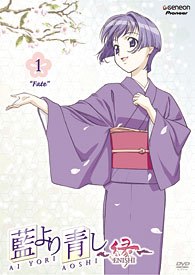Christopher Harz pays a visit to one of the hottest vfx havens, Londons Soho district, which has attracted a flurry of American movies, thanks to creativity and tax incentives.
Around 1995, Japanese animation (anime) began pouring into North America, Europe and across the globe in video form. Most of these titles were unknown outside of Japan and never covered by animation journals. Whether a title is highly popular or very obscure, a high quality theatrical feature or a cheap and unimaginative direct-to-video release, they all look the same on a store shelf. Therefore, Animation World Magazine will regularly review several new releases (including re-releases not previously covered) that have merit.

Ai Yori Aoshi, or Bluer than Indigo, brings true heart and humor to this first love tale.
Ai Yori Aoshi. V.1, Faithfully Yours. V.2, My Dearest. V.3, Hugs and Kisses. V.4, Truly Yours. V.5, With All My Heart.
TV series (24 episodes), 2002. Director: Masami Shimoda. V.1-4, five episodes/120 minutes; v.5, four episodes/100 minutes. Price & format: DVD bilingual $29.98. Distributor: Geneon/Pioneer Entertainment.
Ai Yori Aoshi: Enishi. V.1, Fate. V.2, Bond. V.3, Destiny.
TV series (12 episodes), 2003. Director: Masami Shimoda. V.1-3, four episodes/100 minutes. Price & format: DVD bilingual $29.98. Distributor: Geneon/Pioneer Entertainment.
Ai Yori Aoshi (Bluer Than Indigo; for some reason the American distributors have retained the untranslated title) is an adolescent first love comedy (24 episodes, broadcast April 10 to September 26, 2002; animated by J.C. Staff) that emphasizes tender romance over wacky fantasy, although there is plenty of humor. Kaoru Hanabishi is a college student living alone who is dumbfounded to have a playmate from his infancy visit him. Kaoru was the heir of an ancient noble family who rejected its haughty arrogance years earlier, and has been living on his own merits since then. He only dimly remembers Aoi Sakuraba as a playground companion. But she is the heir of a powerful business dynasty, and their parents had planned their marriage from their birth. Kaoru never knew this, but Aoi has grown up expecting to wed him some day.
The news that the Hanabishis have finally given up expecting Kaoru to return and have disinherited him, and that the arranged marriage has been cancelled, has shocked Aoi into determining to meet Kaoru for the first time in their adult lives and decide for herself how she feels about him. Kaoru is equally shocked to find a nervous girl who is practically a stranger proclaiming herself his fiancée, but he can appreciate her desire to break free from the arbitrary life that her family has planned for her.
Thanks to the machinations of romantic comedies, the Sakurabas devise a plan to let Aoi get her romantic foolishness out of her system. One of their minor estates is turned into a college rooming house with Kaoru as the main tenant, Aoi as the titular landlord, and attractive but stern Miyabi Kagurazaki as a combination manager/duenna/housemother to make sure nothing improper goes on. Some of Kaorus college classmates (all girls) also move in, and Ai Yori Aoshi soon has the requisite anime love comedy cast of one well-mannered, shy guy living in a household of attractive, free-spirited girls (Tina Foster, a Japanese parody of American big-breasted, sexually-uninhibited blondes; Taeko Minazuki, the well-meaning klutz who is always accidentally breaking things; a new girl every few episodes to provide more variety).
All the formula situations are here: Kaoru trying to study for the big exam despite frustrating interruptions by his rowdy pals; the summer beach party; which girl is the best cook; the visit to the hot springs; Kaoru innocently stumbling upon one girl or another in embarrassing circumstances; and, of course, developing romances among the supporting cast.
In the three-episode dramatic finale, Aois parents realize that their plan is not working and call her home for a new arranged marriage designed to increase the Sakurabi financial empire. Kaoru and Aoi must decide whether they truly love each other enough to defy her father. The series was popular enough that a 12-episode sequel, Ai Yori Aoshi: Enishi (Bluer Than Indigo: Fate), appeared a year later on Japanese TV (October 5 to December 28, 2003). It is scheduled for an American three-volume DVD release in July, September and November.

In Battle Doll Angelic Layers game world, girls get a chance to play.
Angelic Layer. V.1, Divine Inspiration. V.2, On a Wing and a Player. V.3, Idol Worship. V.4, Faith, Hope & Love. V.5, Deus ex Machina. V.6, Inherit the Layer. V.7, Seventh Heaven.
TV series (26 episodes), 2001. Director: Hiroshi Nishikiori. V.1-5, four episodes/100 minutes; v.6-7, three episodes/75 minutes. Price & format: DVD bilingual $29.98. Distributor: A.D.V. Films.
Young girls have always wanted to play with their brothers toys. That is the premise behind Battle Doll Angelic Layer (Kido Tenshi [literally Mobile Angel] Angelic Layer), the equivalent for girls of such boys gaming anime series as Yu-Gi-Oh! and Beyblade. This 26-episode TV series (April 1 through September 30, 2001, animated by Studio BONES) was based upon a popular manga by CLAMP, the creator of Card Captor Sakura.
Twelve -year-old Misaki Suzuhara has just arrived in Tokyo to live with her Aunt, and hopefully rejoin her mother whom she has not seen since she was five. At the train station, she gets her first glimpse on a TV newscast of the latest sports/game craze sweeping Japan: Angelic Layer, a martial-arts tournament in which young players manipulate action figures through a high-tech headband that projects their thoughts. Misaki, who is small for her age and poor at athletics, is fascinated by the concept of becoming a miniature gymnast/martial artist through a high-tech surrogate doll. Age or size doesnt matter for Angelic Layer; its a matter of application of willpower and strategic study of your opponents strengths and weaknesses.
The Angelic Layer game is sci-fi, but any child will recognize it and its Piffle Princess toy store chain merchandiser as the equivalent of real games and Japans leading toy manufacturers. Misaki buys her own Angel which she names Hikaru, and begins rising through the ranks of Angelic Layer tournament players at the same time she enters middle school and makes new acquaintances among her classmates. She is unaware that the adults around her are secretly watching her much more intently than the average gamer, due to a subplot only possible in a convoluted soap opera.
The rules and fashions of Angelic Layer, as well as the super-attractive action figures, are developed to a degree that will make any child and many adults wish that it was real. It has both boy and girl players, but the anime series is primarily for girls so those aspects are emphasized. Each player must customize his or her own Angel. Not only Misakis Hikaru, but all the Angels as well as Misaki and her friends themselves look like they were costumed by leading fashion designers (thanks to CLAMP and character designer Takahiro Komori). Most episodes feature at least one suspenseful tournament bout, but the martial-arts action is always subordinate to intelligent strategy. Misaki is always encouraged to learn something new and to advance another step rather than just repeating herself.
Early episodes concentrate almost completely on the Angelic Layer tournament world, and develop a supporting cast from Misakis gaming supporters and opponents. Later episodes develop the personalities of these characters at school and in adolescent social situations (first date, beach parties), gently pointing out that life is about more than just a fascinating game. Misaki and her friends are turning from children into young adults, and Angelic Layer helps them in a wholesome manner.

Gunparade March takes a slice from Starship Troopers and sends teens out to battle giant insectoid monsters.
Gunparade March. Operation 1 - 3.
TV series (12 episodes), 2003. Director: Katsushi Sakurabi. V.1-3, four episodes/100 minutes. Price & format: DVD bilingual $29.95. Distributor: Anime Works/Media Blasters.
Earth has been under attack by genjyu monsters for more than 50 years. The situation is so desperate that, for the past 21 years, high schools have been placed under partial military service as area defense units. The schools are provided with giant robot battle armor, and students are trained as pilots to defend their home communities against monster incursions.
The giant insectoid genjyu are vague boogeymen that never emerge from the background, nor are they supposed to. This is an adolescent slice-of-life soap opera that focuses almost entirely upon teenagers in a world where it has become accepted that a normal high school activity is being sent out on occasional military sorties. The main cast of Gunparade March (12 TV episodes broadcast February 6 - April 23, 2003, animated by the J.C. Staff studio) is Shoukei High Schools Unit 5121, a special class comprised of those students determined to have the highest aptitude for military service, either as battle-armor combat pilots, maintenance technicians or administrative staff.
Atsushi Hayami is a classic shy nerd who wishes that he had failed the aptitude tests, but is determined to do his duty and not let his teammates down. Mio Mibuya is equally determined to prove that a woman can be as good a military pilot as a man. Takayuki Setaguchi is a girl-chasing stud who is sure that being a heroic pilot will help him get dates. Yohei Takigawa acts so juvenile that nobody is sure whether he understands the difference between giant robot TV cartoons and videogames, and real combat. Most of the maintenance and administrative staff are girls with the standard mixture of adolescent girl personalities in high school TV series.
The catalyst for story development is the transfer of a new student to Shoukei High, and how she and the rest of Unit 5121 affect each other: Mai Shibamura, another girl pilot but coldly obsessive about defeating the genjyu, and contemptuous of any students who treat their anti-monster assignments as just another school activity like sports or drama classes.
The 12 episodes are a mixture of adolescent comedy and drama, of typical high-school social scenarios and grim battlefield action. Some of the situations are reminiscent of military humorous dramas like M*A*S*H, but with a cast that pointedly lacks the emotional maturity of adult soldiers. Hayami, Shibamura, Mibuya and their teammates are high-schoolers who are simultaneously getting pep talks about planning for their futures after they graduate, and being sent on combat missions from which they may not return. (Unit 5121 does have fatalities.)
Gunparade March has low key action and a bland sci-fi plot compared to most anime sci-fi dramas, but its characters are appealing and its action is a clear metaphor for its sympathetically practical moral: you are about to grow up whether the future looks rosy or not -- how are you prepared to face it?

Manga turned anime, Steam Detectives has fun with references sources as diverse as Sherlock Holmes to Gigantor.
Steam Detectives. Case 1 - 6.
TV series (26 episodes), 1998-1999. Director: Yasushi Murayama. V.1-2, five episodes/125 minutes; v.3-6, four episodes/100 minutes. Price & format: DVD bilingual $29.98. Distributor: A.D.V. Films.
Kaiketsu Jouki Tanteidan (The Extraordinary Steam Detectives) began as a manga serial by Kia Asamiya in 1994, and had acquired a popular following by the time this 26-episode TV adaptation (animated by XEBEC) aired from October 7, 1998 through March 31, 1999. This steam-punk boys adventure is a tongue-in-cheek tribute to international popular fiction from the 1880s through the 1950s, with recognizable in-group references to Vernean sci-fi, Sherlock Holmes, such 1910s fictional master criminals as Arsene Lupin and Fantomas, numerous boy-detective/inventor series, American 1930s noir crime pulps and 1940s superhero comics, up to Yokoyamas 1950s Gigantor manga.
Steam City is a 1920s-ish everycity with elements of London, Paris and Tokyo where all machines including giant robots (called megamatons) are steam powered. Narutaki, the famous boy detective, helps police Detective Onigawara and Inspector Yagami solve crimes with his megamaton Goriki, which is better than anyone elses. Goriki was built by Kawakubo, Narutakis elderly butler who was a devoted friend of his deceased parents.
Narutaki is also helped by his big-sisterly assistant, the nurse Ling Ling. Together, this group defends Steam City from such costumed villains as the Crimson Scorpion (a femme fatale who only steals valuable beautiful objects), the Machine Baron (who only steals scientific marvels, and who wants Goriki), Le Bled (a debonair boy phantom thief and self-appointed evil alter-ego of Narutaki), Dr. Guilty (a mad scientist who wants to destroy Steam City for refusing to recognize his genius), and Knight Phantom (who bears an insane hatred for Narutaki and vows to kill everyone dear to him).
Steam Detectives is a curiously uneven series. The animation quality is poor and the music is inappropriate. The first 13 episodes are so juvenile and buffoonish as to make the age advisory of 15+ look considerably exaggerated (although some of the humor is very witty); then the last 13 episodes become so brutally and even sadistically melodramatic as to make the age advisory look underrated. Episode #16 is a moral debate between nurses Ling Ling and Lang Lang as to whether a terminally-ill child should be forced to undergo an operation that has less than a 1% chance of saving her, or allowed to die with dignity; this is excellent, very touching, and totally out of place amidst the earlier slapstick humor and the later battle violence.
The DVD extras and liner notes include extensive creators commentaries that will be of more interest to serious anime collectors (Asamiya lists Batman as one of his major influences, plus lots of Japanese manga and early TV anime unknown in America) and animation students (director Murayama points out many problems and flaws due to the limited budget and short production time) than to average anime viewers. It is hard to guess for whom Steam Detectives is most appropriate.

Yukikazes smart story and high-tech, sci-fi, aerial-combat may attract fans Top Gun and The Right Stuff to The X-Files.
Yukikaze. V.1, Danger Zone. V.2
OAV series (5 episodes) 2002-2004 Director: Masahiko Ohkura. V.1, 2 episodes/74 minutes (+ 30 minutes of extras). Price & format: DVD bilingual $29.98. Limited edition: $39.98. Distributor: Bandai Entertainment.
Bandai Visual, the Japanese entertainment megacorp, commissioned the GONZO Digimation studio to produce this Bandai home-video 20th anniversary five-episode OAV series in the latest cutting edge computer animation. GONZO is known for producing excellent animation even if it has to run way behind schedule to do it right. That seems to be what is happening here; the releases of the first four episodes of Sento Yosei Yukikaze (Battle Fairy Yukikaze) have been stretched out in Japan from August 25, 2002; February 25 and August 22, 2003; to April 23, 2004. The release date of the final OAV has not been announced yet.
This air combat/sci-fi drama is heavy on very realistic in-the-cockpit visuals that give the impression of an actual fighter-pilot training display (or an exceptionally realistic videogame). The setting is a military community on an Earthlike alien planet, Fairy. 33 years earlier, alien monsters from Fairy tried to invade Earth through a hyperspace passage. Earth beat the aliens back through the passage, established a beachhead on their world, and has been fighting there ever since. The human community that has grown there is heavily dominated by an Air Force mission and mentality
Like many troops in the field, they feel more in touch what is really going on than their distant commanders (back on Earth). They also have mixed feelings about the latest experimental artificial intelligence technology being added to their fighter planes computerized controls. Some welcome anything that may increase their chances of survival, while others resent that their superiors may be using them as expendable guinea pigs.
Jack Bukhar and Rei Fukai are the pilot and co-pilot of the Boomerang Squadrons plane B-3, the Yukikaze (snowwind). Bukhar is a normal fighter jock while Fukai is a loner, introspective to the point of surliness. Despite this, they have become close friends. Bukhar is eventually promoted to a command position and Fukai becomes the units top pilot. Fukai is not interested in promotion out of his fighters cockpit; he is developing an obsessive fondness for the Yukikaze that makes Bukhar increasingly nervous. Fukai thinks the Yukikazes latest AI upgrades have given it awareness and that it talks to him.
Is Fukai is becoming unstable? Is this making him a worse, or better pilot? Could it be true? If so, could the Yukikazes intelligence be a scientific accident, or a Top Secret experiment that he is not supposed to be aware of? Could it even be a new type of stealthy attack by the aliens to infiltrate the humans defenses?
Yukikaze may not have the CGI-level animation of The Animatrix, but it is still extremely impressive. The GONZO crew has crafted an intelligent story that plays to their technical strengths; a good-buddy high-tech sci-fi aerial-combat drama that will appeal to fans of movies ranging from Top Gun and The Right Stuff to The X-Files. But fans will have to wait for the series completion. This American DVD vol. 1 contains only the first two episodes (47 and 27 minutes), although there are lots of extras. There is no telling when the second DVD with the final three half-hour episodes will be released in America. Vol. 1 comes in both a one-disc standard version and a Limited Edition two-disc version with DTS enhanced CGI.
Fred Patten has written on anime for fan and professional magazines since the late 1970s. He wrote the liner notes for Rhino Entertainments The Best of Anime music CD (1998), and was a contributor to The World Encyclopedia of Cartoons, 2nd Edition, ed. by Maurice Horn (1999) and Animation in Asia and the Pacific, ed. by John A. Lent (2001).







